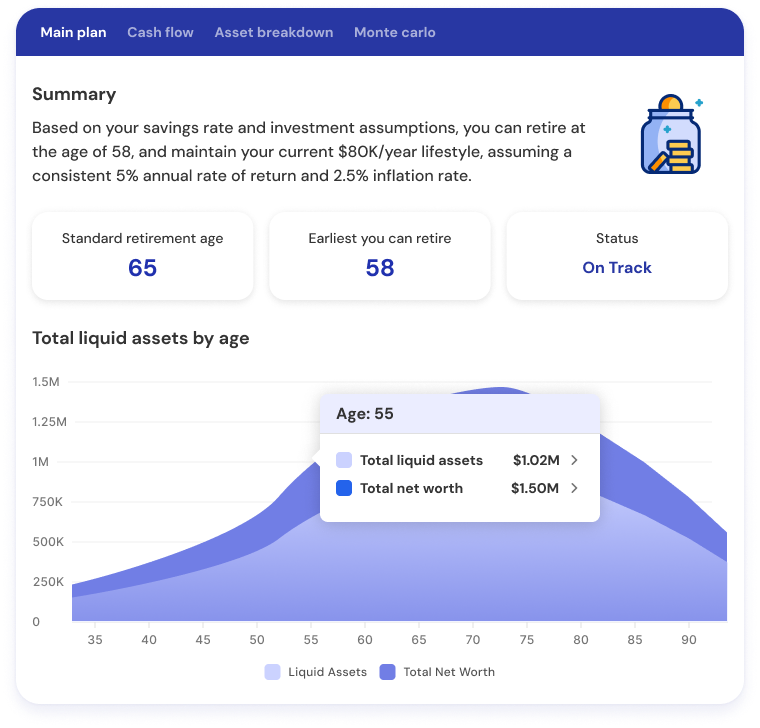A Straightforward Approach to Determining Total Assets and Net Worth

Defining Total Net Worth
Total Net Worth is a snapshot of your financial well-being and is derived by calculating the total value of all assets after subtracting debt and liabilities.
Total Net Worth = Total Assets – Total Debt (or) Liabilities.
Planwell’s financial planning software helps you track your net worth. It automatically computes the total net worth from the assets and liabilities.
How to Calculate Total Assets
Total assets refers to the financial value of everything that you own including cash, stocks, real estate, retirement accounts, crypto and any other alternative accounts. As you can see, there are many types of assets one can own based on the expected growth, your risk appetite and the need for diversification.
Planwell helps break down your assets and projects them throughout your lifetime based on growth rate assumptions before and after retirement.
Types of assets
Liquid assets
Liquid assets are assets that can be easily converted to cash at a predictable value. They can, therefore, be tapped for emergencies or to fund major goals such as home remodeling or putting in down payment for a new home.
Liquid assets include cash, cash equivalents such as certificates of deposits, treasury, bonds. You can input your liquid assets into Planwell to help you plan for your goals.
Long term assets
Long term assets include retirement assets such as 401Ks or IRAs that accumulate value over time. These assets may not be readily available in an emergency or to pay for a goal, or may involve penalties if you want to convert these assets to cash, as is the case with 401Ks before retirement age. Planwell uses your retirement assets as input into helping determine your readiness for retirement and whether your funds will last through your lifetime.
Tangible assets
Tangible assets are physical assets that can be touched and seen such as land, real estate, gold, or vehicle. Below are examples of tangible assets
- Primary home or real estate investments.
- Vehicles
- Gold and jewelry
Tangible assets can undergo depreciation over time, for example, cars lose roughly one fourth of their value when you drive them off the car dealer’s lot.
Intangible assets
Intangible assets refer to non-physical digital or ‘abstract’ assets which have monetary value associated with them.
Examples include:
- Crypto assets or NFTs.
- Copyrights, trademarks or patents.
The Importance of Asset Diversification
The benefit of having a mix of different types of asset classes is diversification. For eg, if the stocks go down, having assets in real estate or alternative investments can help with mitigating the risk.
How to Work Out Total Liabilities
Total liabilities include debt such as your home mortgage, student loans, credit card loan, car loans and so on. It also includes a home mortgage.
Total Liabilities = Remaining balance on all your debt.
Benefits of Calculating Total Net Worth
Understand if you are on track for financial goals
Total net worth can help you understand whether you are positioned well for financial goals such as retirement, paying for kids’ college, or buying a home.
Retirement Goal
By projecting your net worth until retirement, you can calculate whether you will have enough money for retirement. FIRE enthusiasts can even calculate the earliest age of retirement.
How to calculate the earliest age of retirement
- Calculate the sum of your liquid assets (cash, stocks) plus retirement accounts at retirement age.
- Think about the type of lifestyle you might want to have in retirement. There are many options such as Fat FIRE (a luxurious retirement lifestyle), Lean FIRE (a very frugal retirement ) or somewhere in between (Chubby FIRE or old fashioned Standard FIRE).
- Crunch the numbers to see if the amount you have saved up at retirement will support your lifestyle throughout your retirement years.
- If you plan to retire before 65, you should not rely on retirement tax advantaged funds before retirement age. You should plan to use your liquid assets (cash, stocks, mutual funds) until age 65 and then start tapping into retirement accounts from age 65.
How to think about real estate assets
Real estate is not a liquid asset and you may not be able to sell it immediately to pay for emergencies or other goals like a child’s college. However, the appreciation in real estate and home values can help you build home equity over the longer term. Many people sell their larger primary home when kids are grown up, and the appreciation can come in handy to fund retirement.
Rental income from real estate can be useful as a nice side income to help when you retire early. There are options such as house hacking to help you get the benefits of real estate while reducing home related expenses. However make sure that the cash flow from real estate is positive after accounting for mortgage payments, maintenance and other expenses.
Home Buying Goal
If you plan to buy a new home, you will need funds for down payment. These funds will come from the assets you have accumulated in the form of cash, brokerage accounts, stocks or mutual funds. By calculating your net worth and breaking it down by type of assets, you will know whether you can sell your liquid assets to put towards the downpayment. If you have enough assets, you may even be able to buy a new home with cash.
Kids’ College Goal
Calculate how much you need for your kids’ college. Then evaluate whether you have enough saved in your 529s or other liquid assets that can be used to fund the college expenses when the child is ready to go to college.
Make Tradeoffs Between Goals
Calculating net worth helps you make tradeoffs between all different goals, since the funds for achieving your goals come from the same set of assets that you have saved.
Conclusion
Tracking your net worth is useful to understand your financial position and readiness to achieve your goals such as retirement or early retirement, paying for kids’ college or buying a home. It is important to have a mix of liquid, long term and tangible assets to plan for different goals at different stages of your life and to manage risk.
Planwell can help you track your net worth with our fully automated financial planning tool. Furthermore, it can help you plan for multiple financial goals such as kids’ college, retirement and home buying.
- What is Coast FIRE? Find out how to Coast Your Way to Financial Independence.
- What is barista FIRE? Retire early and work part-time.
- Lean FIRE: The frugal way to achieve financial independence and retire early.
- How to retire early and achieve financial independence: Tips to retire early and achieve FIRE (Financial Independence, Retire Early)
- How to build a personal financial plan: Before you make a home purchase, make sure to build your personalized financial plan with our 10 step guide.
- How to Use AI Budget Calculators and Tools to Plan Your Finances: Take advantage of our free FIRE calculator to plan your finances more effectively.
- 5 Common Money Mistakes to Avoid: Learn about the pitfalls that could derail your early retirement plans.
Related Posts
About
©2023 Planwell.io


